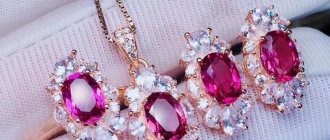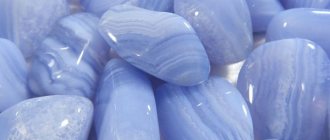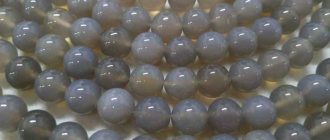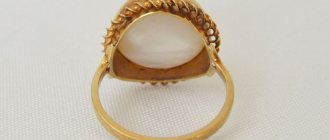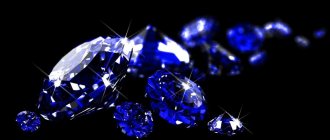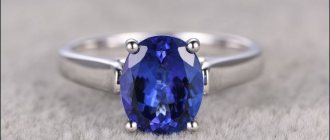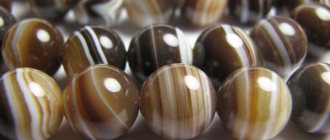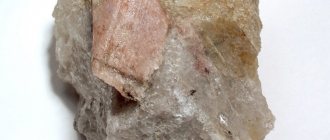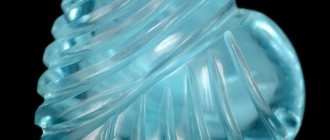Precious and semi-precious gems in yellow hues are popular and prized for their stunning appearance. Such specimens look elegant and noble in jewelry. In addition, the yellow stone, associated with the sun and warmth, is endowed with healing and magical powers that can change a person’s health and life for the better.
The meaning of yellow
Cheerful sunny minerals include examples of orange, gold, lemon, honey, and light and dark yellow. These colors are perceived as bringing light, happiness, warmth and love. Perhaps this is why yellow stones give a person optimism and positive emotions, and the Japanese believe that this color gives willpower and courage. For the ancient Egyptians, yellow was associated with the supreme god of the Sun - Ra, was expensive and was inaccessible to “mere mortals”.
Gems are divided into precious (which are less common) and semi-precious (which are found more often). Another factor that adds value is quality.
Substances that give color to minerals are sulfur, iron and lithium. The exception is amber, whose color is determined by the resin content.
There are opaque, translucent and completely transparent samples. This also determines the price, while stones of yellow tones are less common in nature than, for example, red or blue, and, accordingly, are more expensive.
Common Varieties of Fool's Gold
Some of the most common varieties of pyrite are bravoite, chalcopyrite and marcasite.
- Bravoite - it contains a small proportion of nickel, which is why it has a pale golden color and a beautiful shiny surface. Bravoite also has a metallic sheen and sharp edges of regular shape. Due to the fact that the nickel content in bravoite reaches up to 20%, it is considered to be nickel ore.
- Chalcopyrite - also called copper pyrite, has a large proportion of copper in its composition. Its color is already brighter, sometimes even more reddish. It is not very common in industry as it is very fragile.
- Marcasite (or rainbow mineral) – it contains cobalt, thallium, and lead. Although it is fragile and short-lived, this mineral is highly prized by jewelers. Unlike pyrite, marcasite does not form large crystals; it appears as finely crystalline masses. The color of marcasite is very beautiful, iridescent. Due to its special structure, this mineral can be cast in all sorts of, almost any colors.
Precious minerals
The following yellow precious minerals can be distinguished:
Diamond
One of the rare gems of the world. Among the diamonds mined, only every hundred thousandth specimen is yellow in color. It is a clear crystal; shades of diamonds are light yellowish, bright lemon and golden, there are even tangerine shades. The gem is very expensive, for example, a 13.4-carat specimen was sold at auction for 3 million (in 1997).
Sapphire
The classic color of the stone is blue; yellow crystals are rare, with shades ranging from light to golden amber. There are specimens with such a pale color that they are classified as colorless. The minerals are unevenly colored; stripes and inclusions are usually darker than the main tone. Stones of pure color are rare, so they are expensive. The places where sapphires are mined are the islands of Madagascar and Ceylon, as well as Burma.
Topaz
This is a transparent crystal with a natural yellow color. There are polychrome samples containing brownish or greenish tints, but this is rare. The color of the crystals may change from yellow to pink (during heat treatment). This procedure is carried out in laboratory conditions. Topaz fades when exposed to direct sunlight, so items lose color over time.
Tourmaline
The standard color of the mineral is crimson; precious yellow stones are rare (they are called drayites). The shade is often uneven, with blue, pink or brown inclusions. Depending on the color saturation, transparency and frequency of inclusions, tourmaline is also classified as semi-precious or ornamental minerals. Currently, production is carried out only in Kenya.
Opals: facts from history and events of our days
The love for precious opal stones was passed on to modern people from our distant ancestors. The ancient Roman writer Pliny called the mineral “the love of a youth.” And the Roman senator Nonnius, who had real wealth - a magnificent ring with a large opal, ended his life in poverty and exile. He never agreed to exchange his beloved item for the untold riches that Mark Antony promised him.
An insert of a luxurious gem was present in the crown of Emperor Constantine, who ruled the Holy Roman Empire. The noble person firmly believed in the magical properties of opal. Constantine believed that the mineral protected the power, life and honor of its owner. He also had no doubt that the gem was capable of making its owner invisible in case of special need. This belief was the reason that in medieval times opal gained fame as a talisman for robbers and thieves. Aristocrats turned away for a long time from the noble stone, which had a bad reputation. He was considered the main attribute of black magicians and alchemists, the “eye of evil.”
A few decades later, the precious stone opal came back into fashion. He was especially popular with blondes. Blonde ladies believed that jewelry made from an unusual stone could make blond hair even more beautiful. The reigning people could not remain indifferent to the beautiful mineral.
Silver SOKOLOV earrings with cubic zirconia and opals (go to the SUNLIGHT catalog)
Various types of opals were held in special esteem by the Italian Medici family, Queen Victoria of England, the Frenchwoman Josephine Bonaparte and the Russian Empress Alexandra Feodorovna.
Gems gained particular popularity throughout the world after rich Australian deposits were discovered. To this day, about 90% of specimens are mined in this country. It was here that the largest representatives of the species were found - black Australian opals. But this discovery was not the most unusual. In 1909, experts discovered in one of the opal mines the skeleton of a reptile resembling a snake. Its length was about 15 cm. But the most unusual thing was that the skeleton was completely opalized, all its parts were replaced by pebbles. The original find was sold to a private collection.
Semiprecious stones
The following semi-precious yellow stones are distinguished:
Heliodor
A gem of rich golden tones. There are samples of honey color, the brightness depends on the amount of iron impurities. Heliodor means “gift of the sun” in Greek. Another name for the stone is yellow beryl. This is a transparent crystal, which is usually used in its natural form. However, if the color of the specimen is unsaturated or interspersed, the minerals are subject to heat treatment. This causes the gem to become transparent or change color to bluish. Heliodor deposits have been discovered in Russia, India, Ukraine and Brazil.
Citrine
A variety of quartz with rich tones (from light lemon to bright orange). There are dark orange specimens called Madera. The crystals are mostly half or completely transparent, yellow stone is rare. Therefore, some citrine is grown in laboratory conditions. Natural gemstones are mined in the USA, Russia (in the northern part), as well as in France and Brazil.
Zircon
Natural stone is transparent, hard and with a pronounced shine. Also goes by the name "Yargon". Colors are yellowish or golden. After heat treatment it turns greenish, turquoise or red. Zircon deposits are located on the island of Madagascar, Canada and Thailand. In Russia, deposits of the mineral were found in Kamchatka, Yakutia and the Urals.
Pomegranate
The yellow color is not typical for this stone, but such specimens do occur. Mined in small quantities. Garnet is used to make rings, earrings, and beads; the cut is made in the shape of a ball or oval. Medicinal properties include a positive effect on breathing and joints, as well as the ability to regulate high blood pressure.
Large pyrite deposits
Mining pyrite is a fairly inexpensive business, since it is located next to other, usually more valuable metals, and there is no need to mine it separately. Pyrite deposits are located all over the world, but the largest are in Russia, the USA, and Sweden. It is also mined in Azerbaijan, Spain, and Norway. But the most interesting and valuable samples are supplied only by Italy.
Decorative and ornamental
Representatives of this group are usually opaque. This is the main difference between gems and precious or semi-precious ones.
Cornelian
A variety of quartz belonging to the chalcedony group. The origin of the stone is volcanic, the color is often uneven, with stripes and inclusions. In terms of healing properties, the mineral is similar to other representatives of the “yellow” group; it has a beneficial effect on the stomach, digestion and thyroid gland. Carnelian is mined in China, where it is considered a stone of longevity.
Amber
A gem of sunny bright tones, its origin is the petrified resin of ancient coniferous trees (over 100 thousand years old). Coloring - gold, honey, yellow and orange tones. Amber deposits have been found on the Baltic Sea coast. The stone has strong healing and magical properties and is used in the treatment of a number of diseases (including the thyroid gland) and as a talisman.
Jasper
An inexpensive ornamental stone used to create necklaces, bracelets, earrings and rings. Gives jewelry a luxurious look (despite the low price). Jasper comes in shades of yellow. There are also yellow-green tones.
Agate
A popular ornamental gem with various shades of yellow: light, lemon, brownish. Natural samples often contain inclusions and stripes. Laboratory-grown agate has a purer and richer color.
Nephritis
The yellow color is atypical for this gem; green stones are more common. Jade crystals are opaque; to make necklaces and beads, they are polished, and for earrings and rings, they are processed using the cabochon technique. Shades of yellow - from light to dark, deep and rich.
Use of pyrite in industry
In industry, this mineral has received very wide application; it is used in a variety of fields. Sulfuric acid is obtained from it, pyrite cinders can be used as iron ore, added to concrete, chemical waste is purified from chlorine impurities, and sometimes gold, nickel, chromium, cobalt, silver, and copper are extracted from it.
Jewelers make a variety of jewelry from it. This stone is inserted into gold and silver, sometimes even in its raw form. And large rainbow pyrite stones with regular geometric shapes have real value for collectors and can be quite expensive.
Magical and healing properties
It is known that yellow gemstones have strong energy and have a beneficial effect on humans. Crystals give a charge of vigor and optimism and fight a number of diseases. It is believed that the greatest power comes from transparent semi-precious and precious minerals.
Wearing items with yellow gems is recommended:
- people with digestive problems;
- patients with stomach and intestinal diseases;
- to improve the condition of the heart and blood vessels;
- with high blood pressure;
- to relieve tension (especially from the eyes).
Esotericists endow stones of solar shades with magical powers, so they contribute to:
- cheerfulness and gaining a positive outlook on the world around you;
- building willpower and self-confidence;
- strengthening relationships with friends and colleagues;
- peace and harmony in the family;
- protection from ill-wishers.
How to recognize a fake
Yes, despite its cheapness, “fool’s gold” is also counterfeited. And in the simplest way, ordinary paint is applied to plastic or glass. It is quite easy to recognize whether it is a fake or not. Look carefully at the light, pyrite is always opaque, or run your fingernail over the product, if a scratch is formed, it means that it is spraying, and you are being deceived.
It is also not difficult to distinguish pyrite from gold. Gold is softer and more pliable, has a streamlined shape, while pyrite, on the contrary, is hard, has sharp edges, and in appearance it is more like a crystal. Also, gold, unlike pyrite, does not enter into chemical reactions with most substances. And the shine of gold in the light is completely different from that of false gold, which loses its shine in the light.
Yellow stones and zodiac signs
The color of the minerals of this group represents brightness, sun and warmth, so they are most suitable for representatives of the element of Fire (Sagittarius, Aries and Leo). Yellow gems will charge you with additional energy, make you more cheerful and confident, and transparent stones - sapphire and topaz - will calm emotional natures and give wisdom and sound thinking.
Women - representatives of the fire signs of the Zodiac - will receive peace in the family and smooth, warm relationships with loved ones, and men will receive success in business and career growth. “Cheerful” minerals will help you establish business contacts with partners and conclude profitable deals.
The only sign for which yellow crystals are not recommended is Scorpio. The rest can fearlessly choose and wear them as a talisman.
Short description
According to its physical properties, opal is a solid hydrogel of silicon oxide. It is close in quality to quartz, but differs from the latter in its variable moisture content. The amount of water in the rock ranges from 0.4 to 32%. The properties of stones, as well as their jewelry value, largely depend on the concentration of the liquid. Noble opal should contain from 6 to 10% water. Such specimens are especially prized by jewelers. The more moisture a mineral contains, the more transparent it is. A stone that dries completely becomes completely opaque. At the same time, it loses its properties, may crack and even crumble.
Gold earrings with cubic zirconia, opals and citrines (go to the SUNLIGHT catalogue)
The name of the minerals is translated from the Saxon language as “gems”. Indeed, for their stunning beauty they have gained enormous popularity in jewelry. Opals are often used to make earrings, brooches, bracelets, and pendants. Framed by precious metal, the mineral looks simply magnificent.
Jewelry with yellow stones
Colored minerals have long been in demand for creating jewelry. Craftsmen often use yellow precious and semi-precious stones for their work. Multi-colored transparent crystals are especially valued, giving the products luxury and elegance. These are, for example, jewelry with yellow sapphires, diamonds or topazes, and often gems of golden and honey tones are adjacent to samples of other tones.
Ornamental and decorative specimens are used to make beads, earrings, necklaces, rings and pendants. Gems, for example, representatives of the chalcedony group, are used for interior decoration, inlaying vases, paintings and mirrors.
Caring for products made from natural minerals is not difficult. In order for things to maintain their appearance and please the eyes of others, it is enough to follow simple rules:
- avoid contact with cosmetics and perfumes;
- store in special jewelry boxes;
- do not use chemicals for cleaning (only soap and water);
- Opaque samples should be wiped with a soft cloth from time to time to maintain shine.
Bright sunny stones will decorate every person and his home, give vigor and awaken interest in life. And with proper care, they will remain attractive and give their owner their positive energy.
Who is pyrite best suited for?
Jewelry made from pyrite can be worn by almost everyone. It will have a good effect on the entire body. A man who wears pyrite products becomes confident in himself, and women begin to be attracted to him. But this stone is for those who like serious long-term relationships, and not for lovers of short-term hobbies. It’s also much easier for girls to find their man with the help of pyrite.



